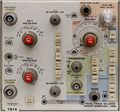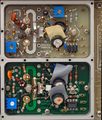7S14: Difference between revisions
(headline) |
(pictures) |
||
| Line 2: | Line 2: | ||
title=Tektronix 7S14| | title=Tektronix 7S14| | ||
summary=1 GHz dual-trace, delayed-sweep sampler| | summary=1 GHz dual-trace, delayed-sweep sampler| | ||
image=Tek 7s14.jpg| | image=Tek-7s14-front.jpg| | ||
caption=7S14 front| | caption=7S14 front| | ||
introduced=1974 | | introduced=1974 | | ||
| Line 36: | Line 36: | ||
There are two 1.35 V mercury button cells, BT1 and BT2, in the sampler circuit. | There are two 1.35 V mercury button cells, BT1 and BT2, in the sampler circuit. | ||
They act as floating bias sources, so if a 7S14 stops working it may be not defective, | They act as floating bias sources, so if a 7S14 stops working it may be not defective, | ||
just dead | just the batteries are likely to be dead. First check the voltage on the cells. | ||
The original mercury cells can be replaced with other (less toxic) methods of | |||
methods of bias voltage generation. Two obvious solutions are photovoltaic | bias voltage generation. Two obvious solutions are photovoltaic cells or modern batteries. | ||
cells or modern batteries. The issue has been discussed extensively | The issue has been discussed extensively on the Yahoo TekScopes forum, so search the archives | ||
on the Yahoo TekScopes forum, so search the archives there for more information. | there for more information. Notably, Ed Breya posted [[7S14_repair|detailed notes on the 7S14 bias cell issue]]. | ||
Notably, Ed Breya posted [[7S14_repair|detailed notes on the 7S14 bias cell issue]]. | |||
The 7S14 has an integrated delay measurement function. | The 7S14 has an integrated delay measurement function. | ||
| Line 62: | Line 61: | ||
<gallery> | <gallery> | ||
File:Tek-7s14-front.jpg | 7S14 front panel | |||
File:Tek-7s14-left.jpg | Left side | |||
File:Tek-7s14-right.jpg | Right side | |||
File:Tek-7s14-sampler.jpg | Sampler boards detail with cover removed | |||
File:Tek-7s14-trig-detail.jpg | Trigger board detail - tunnel diode oscillator (CR220, CR221, L220) | |||
File:7s14 samp.png | Sampler schematic | |||
File:7s14 trig2.png | Trigger schematic | |||
</gallery> | </gallery> | ||
[[Category:7000 series combined plugins]] | [[Category:7000 series combined plugins]] | ||
[[Category:Sampling plugins]] | [[Category:Sampling plugins]] | ||
Revision as of 04:52, 6 June 2015
Template:Plugin Sidebar 2 The Tektronix 7S14 is a 1 GHz dual-trace delayed sweep sampler plug-in. It is almost identical to the 5S14 plugin for the 5000 series.
It is a complete sampling system unlike, for example, the 7S12, which requires a separate timing plug-in to provide triggering and sampling pulse generation.
Key Specifications
| Rise time | 350 ps (1 GHz bandwidth) |
|---|---|
| Vertical deflection | 2 mV/Div to 0.5 V/Div in 1—2—5 sequence |
| Sweep rate | 100 µs/Div to 100 ps/Div in 1—2—5 sequence |
| Input impedance | 50 Ω |
| Maximum input voltage | 5 V peak |
| Features |
|
Internals
The 7S14 contains two samplers, trigger and sweep circuitry, and circuitry to interface it with the 7000-series mainframe in which it operates. The mainframe provides the 7S14 with power. The 7S14 sends the mainframe horizontal, vertical and readout signals.
There are two 1.35 V mercury button cells, BT1 and BT2, in the sampler circuit. They act as floating bias sources, so if a 7S14 stops working it may be not defective, just the batteries are likely to be dead. First check the voltage on the cells. The original mercury cells can be replaced with other (less toxic) methods of bias voltage generation. Two obvious solutions are photovoltaic cells or modern batteries. The issue has been discussed extensively on the Yahoo TekScopes forum, so search the archives there for more information. Notably, Ed Breya posted detailed notes on the 7S14 bias cell issue.
The 7S14 has an integrated delay measurement function.
The 7S14 has two triggering modes: triggered and HF-sync. In triggered mode, the signal passes through two stages of MC1672 ECL logic gate, and then into the 155-0109 trigger chip. In HF-sync mode, the 7S14 uses a BD4 back diode (0.1 mA, 3 pF), and inductor, and a 152-0177-00 tunnel diode (10 mA, 4 pF) to form an oscillator that oscillates somewhere between 16.5 MHz and 25 MHz.
The sampler used by the 7S14 is a two-diode design. Each of the two input channels has its own sampler.
Links
Pictures
-
7S14 front panel
-
Left side
-
Right side
-
Sampler boards detail with cover removed
-
Trigger board detail - tunnel diode oscillator (CR220, CR221, L220)
-
Sampler schematic
-
Trigger schematic




